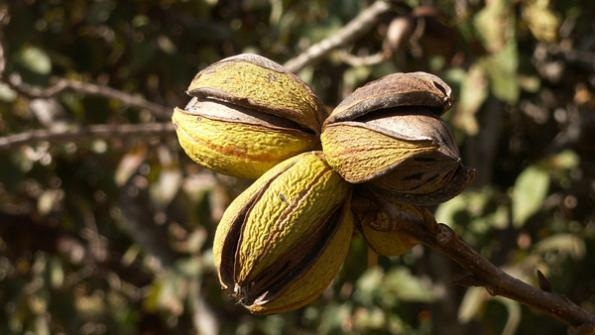
After a stressful drought year for Texas pecan growers, 2012 is shaping up to be a promising year with orchards across the state showing positive signs of healthy trees and early indications of positive nut development.
Texas AgriLife Extension program specialist and horticulturist Monte Nesbitt reports pecan trees statewide appear healthy on orchards where water is readily available, but says the Texas Hill Country region is experiencing signs of dead branches in tree canopies and a lack of new growth as a lingering result of last year’s drought.
“Overall the outlook for pecans is optimistic statewide. Last year was supposed to be a good year for pecans but the drought and extreme heat adversely affected the final outcome. But this year, which would have been an off year, is shaping up nicely so far with lower numbers of pecan nut casebearers,” Nesbitt said.
Casebearers, one of the most important nut-infesting insect pests of pecan, are found in all pecan growing regions of Texas and in southeastern New Mexico. Casebearer larvae represent a triple threat to pecan growers in the Southwest when they tunnel into nutlets shortly after pollination, often destroying all nutlets in a cluster.
Overwintering larvae develop into moths that emerge in April and May and lay eggs on pecan nutlets soon after pollination. These eggs result in first-generation larvae, which feed on nutlets and generally cause the most damage. Second-generation larvae attack the nuts in midsummer about 6 weeks after first-generation larvae enter the nut. Third-generation eggs are deposited on nuts from late July to early September. These larvae feed only in the shucks if the pecan shells have hardened.
“The number of reported cases of first-stage casebearers has been generally low this spring and that is an encouraging sign at this point in crop development,” Nesbitt added.
Nut growers are hoping for a good yield this year after last year’s drought dropped average harvest numbers from the usual 70 million pounds to 30 to 35 million pounds in Texas.
“Pecans are the number one orchard crop in Texas and will always be a viable alternative for ag producers. But like all crops, good management and substantial water are key factors in producing a profitable crop. It comes down to water, management and innovation for the serious pecan grower. Pecans represent a great crop choice because pecan farming is mechanized, but like all other farm products, bad things can happen. There are diseases and pests, and as we know too well, drought can play a major role any given year,” Nesbitt said.
But, considering the severity of last year’s drought, he says most pecan orchards fared well and seem to be rebounding where adequate water for irrigation is available and/or where spring rains provided a good start to the season.
Growing demand
Fueling the flame for new orchard start-ups is the growing demand for pecans, both domestically and internationally.
“There is a steady market for pecans domestically, but Texas had partnered with other pecan growing states in an effort to promote pecans in places like China, India and Germany, and so far those efforts have paid off,” Nesbitt reports.
In fact, increased demand and last year’s smaller yields forced wholesale prices up considerably, which was good news for growers who were faced with a smaller harvest. By the time pecan harvest begins in September each year, Nesbitt says much of the crop has already been sold, and the global market is demanding a larger share every year.
“And with the focus on nutrition and health, consumers are learning just how good pecans are and the benefits they provide in the average diet. This is adding to their popularity domestically,” he said.
Nesbitt also points to renewed interest in pecan production in Texas as an indication of pecan’s value as an agriculture crop. Orchards that have been abandoned in the past are garnering the interest of out-of-state investors and many farmers who have left orchards to fend for themselves are now revitalizing their operations.
“As nut demand continues to increase, so will the interest in pecan production.”
For those considering pecan production, whether as an alternate crop on the farm or as a new start up, Nesbitt says a husband/wife team could generate a reasonable second income on as few as 10 to 20 acres, but says commercial operations should start with 80 acres or more.
“Farm equipment related to pecan production is less expensive than most types of farm equipment, but small-acre orchards would take considerably longer to overcome initial equipment investment. For really small, family operations, however, harvesting can be done by hand. But growing pecans for profit requires the right equipment as well as the right land,” Nesbitt warns.
Once an orchard is developed and matures, growers can expect about 1,000 pounds of nuts per acre from 20 to 40 trees. But make certain ample water is available to sustain the orchard. Nesbitt recommends pumps that can provide 10 gallons of water per minute for each acre of trees.A mature pecan tree requires about twoinches of water per week.
About the Author(s)
You May Also Like






